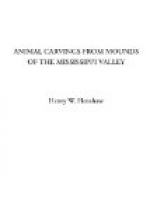It is clearly not the intention of the above authors to claim an entire absence of the grotesque method of treatment in specimens of the Mound-Builder’s art, since elsewhere they call attention to what appears to be a caricature of the human face, as well as to the disproportionate size of the heads of many of the animal carvings. Not only are the heads of many of the carvings of disproportionate size, which, in instances has the effect of actual distortion, but in not a few of the sculptures nature, instead of being copied, has been trifled with and birds and animals show peculiarities unknown to science and which go far to prove that the Mound-Builders, however else endowed, possessed lively imaginations and no little creative fancy.
Decided traces of conventionalism also are to be found in many of the animal carvings, and the method of indicating the wings and feathers of birds, the scales of the serpent, &c., are almost precisely what is to be observed in modern Indian productions of a similar kind.
Few and faint as are these tendencies towards caricaturing and conventionalizing as compared with what may be noted in the artistic productions of the Haidahs, Chinooks, and other tribes of the Northwest, they are yet sufficient to show that in these particulars no hard and fast line can be drawn between the art of the Indian and of the Mound-Builder.
As showing how narrow is the line that separates the conventional and imitative methods of art, it is of interest to note that among the Esquimaux the two stages of art are found flourishing side by side. In their curious masks, carved into forms the most quaint and grotesque, and in many of their carvings of animals, partaking as they do of a half human, half animal character, we have abundant evidence of what authors have characterized as savage taste in sculpture. But the same tribes execute carvings of animals, as seals, sea-lions, whales, bears, &c., which, though generally wanting in the careful modeling necessary to constitute fine sculpture, and for absolute specific resemblance, are generally recognizable likenesses. Now and then indeed is to be found a carving which is noteworthy for spirited execution and faithful modeling. The best of them are far superior to the best executed carvings from the mounds, and, are much worthier objects for comparison with modern artistic work.
As deducible from the above premises it may be observed that, while the state of art among primitive peoples as exemplified by their artistic productions may be a useful index in determining their relative position in the scale of progress, unless used with caution and in connection with other and more reliable standards of measurement it will lead to very erroneous conclusions. If, for instance, skill and ingenuity in the art of carving and etching be accepted as affording a proper idea of a people’s progress in general culture, the Esquimaux of Alaska should be placed in the front rank of American tribes, a position needless to say which cannot be accorded them from more general considerations. On the other hand, while the evidences of artistic skill left by the Iroquoian tribes are in no way comparable to the work produced by the Esquimaux, yet the former have usually been assigned a very advanced position as compared with other American tribes.




